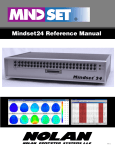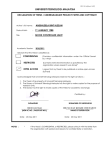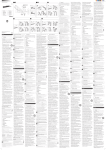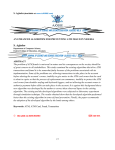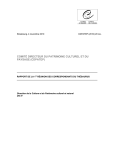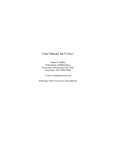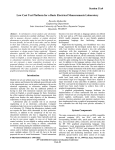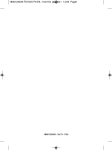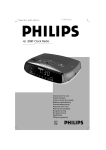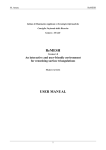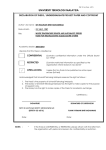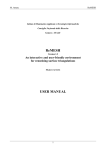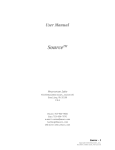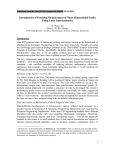Download (eeg) and its associated artifacts - Universiti Teknologi Malaysia
Transcript
VOT 75035 TO STUDY THE CHARACTERISTICS OF ELECTROENCEPHALOGRAM (EEG) AND ITS ASSOCIATED ARTIFACTS (SATU KAJIAN TENTANG CIRI ELECTROENSEFALOGRAM (EEG) DAN ARTEFAK YANG BERKAITAN) NORANI HAMZAH SALWANI MOHD. DAUD SALMIAH BASIR RESEARCH VOTE NO: 75035 Jabatan Kejuruteraan Elektrik Kolej Sains dan Teknologi Universiti Teknologi Malaysia 2006 ii To those whom had contributed to this works. May Allah bless all of us. iii ACKNOWLEDGEMENTS We would like to thank our neurologist colleagues in few hospitals for their information on EEG and the precautions to be taken during recording sessions. We are also indebted to Universiti Teknologi Malaysia (UTM) for the provision of this fundamental research funding from Ministry of Higher Education. Our special thanks to the Librarian in Perpustakaan Sultanah Zanariah UTM for their commitment in obtaining the related literatures for our research works. Last but not least to all of my friends that are not possible to be listed here, whom had supported and encouraged us, may Allah bless all of you. iv ABSTRACT TO STUDY THE CHARACTERISTICS OF ELECTROENCEPHALOGRAM (EEG) AND ITS ASSOCIATED ARTIFACTS Electroencephalogram (EEG) measures brain function by analyzing the scalp electrical activity generated by brain structures. Local current flows are produced when brain cells (neurons) are activated. However, only electrical activity generated by large populations of neurons concurrently active can be recorded on the head surface. The small electrical signals detected by the scalp electrodes are amplified thousands of times, then displayed on paper or stored to computer memory. EEG like all biomedical signals is very susceptible to a variety of large signal contamination which reduces its clinical usefulness. Many researches had discovered that EEG signals are noisy and non-stationary. These EEG signals are contaminated by artifacts due to blinking, eyeball movements and muscle movements. However the main contamination is due to ocular artifacts elicited by blinking and eyeball movements. This research proposed a novel approach of adopting lifting wavelet transform (LWT) to eliminate ocular artifacts. Three basic steps involved were to transform the EEG, hard thresholding the wavelet coefficients and the corrected EEG was obtained by inverse transform these threshold coefficients. It is of paramount important to select a suitable wavelet and threshold value to accomplish this task. Thus, to select a wavelet for artifact removal in electroencephalogram using this method, relative wavelet energies were determined before and after thresholding. Relative wavelet energy (RWE) gives information about the relative energy associated with different frequency bands and can be considered as a time-scale density. RWE can be used as a tool to detect and characterize a specific phenomenon in time and frequency planes. This study concluded that cdf4.4 outperformed db4 and haar wavelets by removing the artifacts at the correct times and frequency bands. (Keywords: EEG, lifting wavelet transform, ocular artifacts, relative wavelet energy) Key researchers : Pn. Norani Hamzah Assoc. Prof. Salwani Mohd. Daud Pn. Salmiah Basir E-mail : Tel. No. : Vote No. : [email protected] 03-26154662 75035 v ABSTRAK SATU KAJIAN TENTANG CIRI ELECTROENSEFALOGRAM (EEG) DAN ARTEFAK YANG BERKAITAN Electroensefalogram (EEG) mengukur fungsi otak dengan menganalisis aktiviti elektrik yang dihasilkan oleh struktur otak. Arus setempat yang mengalir dihasilkan oleh sel otak yang aktif. Bagaimanapun, hanya aktiviti elektrik yang dijana oleh populasi neuron yang besar boleh direkodkan dari permukaan kepala. Isyarat elektrik yang kecil dikesan oleh elektrod scalp dikuatkan beberapa ribu kali ganda, kemudian dipaparkan atau distorkan ke dalam memori computer. EEG sebagaimana isyarat biomedikal yang lain sangat lemah kepada isyarat hangar yang lain yang boleh mengurangkan kegunaan klinikal. Ramai penyelidik telah mendapati yang isyarat EEG adalah terlalu hingar dan tidak diam. Isyarat EEG dicemari oleh artefak yang terhasil daripada kelipan matan, pergerakan bebola mata dan pergerakan otot. Namun demikian hingar utama adalah daripada artefak okular. Penyelidikan ini mencadangkan satu pendekatan baru untuk mengenepikan artefak okular dengan menggunakan penukaran wavelet meningkat. (LWT). Tiga langkah asas yang terlibat dalam LWT ialah penukaran isyarat EEG, penghad aras koefisyen wavelet dan EEG yang bersih didapati dengan menukar semula koefisyen yang sudah dibersihkan daripada hingar. Penggunaan wavelet dan had aras yang sesuai adalah sangat penting. Jadi tenaga wavelet relatif (RWE) dikira sebelum dan selepas pendekatan ini untuk menentukan wavelet yang sesuai. RWE memberi maklumat tentang tenaga relatif yang berkaitan dengan setiap jalur frekuensi yang berlainan dan boleh dianggap seperti density skala-masa. RWE boleh dijadikan sebagai alat untuk mengesan dan membentuk satu fenomena yang spesifik dalam plane masa dan frekuensi. Kajian ini merumuskan cdf4.4 adalah leih baik daripada wavelet db4 dan haar untuk mengenepikan artefak okular pada jalur masa dan frekuensi yang tepat. (Katakunci: EEG, penukaran wavelet angkat lifting, artefak okular, tenaga wavelet relatif) Penyelidik utama : Pn. Norani Hamzah Prof. Madya Salwani Mohd. Daud Pn. Salmiah Basir E-mail : Tel. No. : Vote No. : [email protected] 03-26154662 75035 vi TABLE OF CONTENTS CHAPTER 1 2 3 TITLE PAGE DEDICATION ii ACKNOWLEDGEMENTS iii ABSTRACT iv ABSTRAK v TABLE OF CONTENTS vi LIST OF FIGURES viii LIST OF SYMBOLS x LIST OF ABBREVIATIONS xi LIST OF APPENDICES xii INTRODUCTION 1 1.1 Introduction 1 1.2 Objectives of the Study 2 1.3 Main Contributions 3 1.4 Outline of Thesis 4 LITERATURE REVIEW 5 2.1 Introduction 5 2.2 Previous Works on OA Elimination 6 ALGORITHM AND METHODOLOGY 7 3.1 Introduction 7 3.2 Wavelet Denoising 10 3.3 Relative Wavelet Energy 11 3.4 Methodology 12 3.4.1 12 Determine the Threshold vii 3.4.2 EEG Recordings 4 5 13 RESULTS AND DISCUSSIONS 15 4.1 Experimental Results 15 4.2 Discussions 26 CONCLUSIONS AND FUTURE WORKS 27 5.1 Conclusions 27 5.2 Future Works 27 REFERENCES 28 Appendix 30 viii LIST OF FIGURES FIGURE NO. TITLE PAGE 2.1 10-20 electrode placement (F: Frontal, C: Central, T: temporal, P: Parietal and O: Occipital. The letters are accompanied with numbers by odd number at the left side of the head and even number at the right side of the head) 5 3.1 One step forward lifting operation 8 3.2 Inverse lifting step 8 3.3 Wavelets (a) Haar, (b) cdf4.4 and (c) db4 10 3.4 Mindset 24 13 3.5 A subject wore electrode cap during recording session 14 4.1 Ocular artifacts at most affected channels in FP1, FP2, F7 and F8 16 4.2 Corrections made for every frequency bands for segment 1 for every frequency band using Haar wavelet 17 4.3 Corrections made for every frequency bands for segment 1 for every frequency band using cdf4.4 wavelet 18 4.4 Corrections made for every frequency bands for segment 1 for every frequency band using db4 wavelet 19 4.5 Relative wavelet energy, RWE for channel FP1 for all frequency bands obtained using Haar wavelet 20 ix 4.6 Relative wavelet energy, RWE for channel FP1 for all frequency bands obtained using cdf4.4 wavelet 23 4.7 Relative wavelet energy, RWE for channel FP1 for all frequency bands obtained using db4 wavelet 25 x LIST OF SYMBOLS a j +1 - approximation coefficients d j +1 - detail coefficients ( h, g ) - analysis filters ~ (h , g~ ) - synthesis filters Tj - threshold D j (k ) - wavelet coefficients E ij - energy at each time segment p ij - relative wavelet energy FP1 - EEG recording channel FP2 - EEG recording channel F7 - EEG recording channel F8 - EEG recording channel xi LIST OF ABBREVIATIONS EEG - electroencephalogram EOG - electrooculogram OA - ocular artifact PCA - principal component analysis ICA - independent component analysis USA - United States of America WT - wavelet transform MRA - multiresolution analysis RWE - relative wavelet energy xii LIST OF APPENDICES APPENDIX A TITLE Mindset 24 – Specifications PAGE 30 CHAPTER 1 INTRODUCTION 1.1 Introduction Electroencephalogram (EEG) measures brain function by analyzing the scalp electrical activity generated by brain structures. Local current flows are produced when brain cells (neurons) are activated. However, only electrical activity generated by large populations of neurons concurrently active can be recorded on the head surface. The small electrical signals detected by the scalp electrodes are amplified thousands of times, then displayed on paper or stored to computer memory. EEG like all biomedical signals is very susceptible to a variety of large signal contamination which reduces its clinical usefulness. Many researches had discovered that EEG signals are noisy and non-stationary. It is very important to ensure a true EEG signal is generated from the brain, however this is not possible as there exist artifacts that suppresses the EEG signals. These artifacts are generated by non-neural sources like muscle movements, heart beat, eye movements and perspiration [1]-[6]. However EEG is dominantly affected by eye movement such as blinking and eyeball movements [1]-[6]. These movements elicit voltage potential known as electrooculogram (EOG) that spread across the scalp and contaminate the EEG and is referred as ocular artifact (OA) [1]-[6]. Wavelet transform has emerged as one of the superior technique in analyzing non-stationary signals like EEG. Its capability in transforming a time domain signal into time and frequency localization helps to understand more the behavior of a 2 signal. For instance, the occurrence of OA in the EEG signal can be clearly recognized when this signal is decomposed into few levels with different scales. LWT is known as second generation wavelets that do not shift and translate as in the first classical multiresolution-based wavelets. LWT had simplified the computation mechanism and it is suitable for real-time applications [8]–[11]. 1.2 Objectives of the Study An investigation of OA removal using Lifting Wavelet Transform (LWT) since wavelet transform do not rely on visual inspection and reference EOG channel [7] will be implemented in this research. Wavelet denoising technique introduced by Donoho and Johnstone [11]-[13] has been employed in this study. To get a satisfactory result of OA removal, it is of paramount important to use a suitable wavelet and threshold value. A tool namely relative wavelet energy, RWE to compare the effectiveness of the wavelets was adopted in this thesis. RWE is considered as time-scale density that can be used to detect a specific phenomenon in time and frequency planes [14]-[15]. (i) To record EEG signals from the scalp. (ii) To analyze the properties of the EEG and its associated artifacts using MATLAB. (iii) To compare effectiveness of few wavelets in eliminating the ocular artifacts. 1.3 Main Contributions There are three main contributions of the thesis. First, some recorded data samples of EEG signals from few subjects are stored for future investigations. Second, it can be concluded that cdf4.4 outperformed db4 and haar wavelets in removing the artifacts at correct times and frequency bands. Third, the study show 3 the effectiveness of adopting lifting wavelet transform with the threshold determined in the study. 1.4 Outline of Thesis This thesis is organized in five chapters. Chapter 2 starts with some background on electroencephalogram and explanations on some common artifacts that exist together with EEG. Previous research works on ocular artifacts are also discussed. Chapter 3 discusses the methodology used for the study and explanation on wavelet transform is presented here. Chapter 4 presents the analysis on the experimental results obtained. Finally, Chapter 5 concludes the research works with suggestions on some future works that can be improved. CHAPTER 2 LITERATURE REVIEW 2.1 Introduction Ocular artifact is due to voltage potentials elicited when the eye blinks and moves (round, horizontal and vertical movements). Cornea in human eye is having a positive charge while retina with negative charge [1]-[6] produces a potential difference of about 100mV between them [1], [3]. Thus eye movements and blinking can easily generate the voltage potential known as EOG. Consequently, this EOG spread across the scalp to contaminate the neural potentials, EEG. Many researchers had reported that ocular activity occur in low frequency bands, below 5 Hz [1]-[2], but in the same study made by the researchers [2], suggested that although largest effect is in delta and theta band, there is also some considerable OA effect in alpha and beta bands. Hence there is a basis of not ignoring the upper frequency band; in alpha and beta bands when analysis on OA is done [1]-[2]. They [2] also mentioned that all regions on the scalp were affected by OA in delta and theta bands with the anterior regions have higher power density than the posterior regions. However, for alpha band, the OAs are affected mainly in frontopolar (Fp1,Fp2), lateral frontal (F7,F8) and medial frontal (F3, F4) regions, whereas in beta band OAs are seen affected mostly in lateral frontal, medial frontal and occipital (O1,O2) regions [2]. The electrode sites configuration is as shown in Fig. 2.1. 5 Blinking generates spike-like shapes [1]-[6] with their peaks can reach up to 800 uV and occur in a very short period, 200 – 400 ms [2]. Eye movements produce square-like waves with smaller magnitude and longer duration [1]-[6]. It has been accepted clinically that eyeball make a momentary upward rotation when the eyelid blink, hence the potential change produced is augmented by the effect of eyelid movement [1], [3], [5]-[6]. Evinger et al [3] had reported that a slight downward rotation of the eyes also accompanied by blinks. This finding allow researchers to eliminate OAs in the EEG by considering only one threshold value for a frequency band as proposed in this study. Fig. 2.1 Electrode Placement (top view) (F: Frontal, C: Central, T: temporal, P : Parietal and O: Occipital. The letters are accompanied with numbers by odd number at the left side of the head and even number at the right side of the head) 6 2.2 Previous Works on OA Elimination There are two general methods of removing the artifact. The simplest method is to reject epochs contaminated with OA. The method is fast and easy to implement but it is not practical to be adopted for real-time application. It also results loss of important data if these contaminated epochs are rejected. Thus this approach is unlikely to be a good choice since blinking and eye movements are involuntary movement that can occur very frequent. The second approach is using some complex algorithm of OA removal to obtain corrected EEG [39]-[41]. Some of the techniques used for OA removal or EEG correction are regression, adaptive filtering, principal component analysis (PCA) and independent component analysis (ICA) [44]. Adaptive filtering requires a reference electrooculogram channel to remove the artifact, but a pure EOG signal that contains only ocular artifact is impossible to obtain [44]. ICA is not automated since it requires visual inspection to select their independent components for correction [45] and it was noted by Wallstrom et al. [44] that ICA correction distorted power for a frequency range between 5 Hz – 20 Hz. PCA cannot completely separate OAs from the EEG signals especially when they have comparable amplitudes [45]. Hence, there is still a major challenge in developing a technique to a successful removal of OAs from EEG recordings. This thesis will present an approach to remove ocular artifacts with the adoption of lifting wavelet transform. CHAPTER 3 ALGORITHM AND METHODOLOGY 3.1 Introduction Lifting scheme was introduced by Sweldens in 1995 had simplified the mechanism in constructing wavelets and this approach becomes more practical to be realized for real-time applications [8]–[11]. The scheme does not require the information in Fourier transform because the wavelet transform can be implemented in spatial or time domain [8]-[11]. The basic steps in lifting operations [8]-[11] are: (i) Split: The original signal of length n where n = 2j is separated into two disjoint sets of even and odd samples. (ii) Predict: The predict step replaces the odd element with this difference as in Eqn.(1) and can be considered as high frequency or detail components. Therefore the predict step can be viewed as high-pass filter. This is done by the following equation: d j −1 [n] = x o [n] − P( xe [n]) (3.1) where P is the predict operator. 3) Update: This step replaces the even element with an approximation that is the signal becomes smoother compare to the previous scale. Hence this operation is viewed as low-pass filtering since the smoother signal contains fewer high frequency components. The update equation is as follows: a j −1 [n] = xe [n] + U (d j −1 [n]) (3.2) where U is the update operator. 4) Normalization: The approximation and details coefficients must be normalized in the final step of the transformation. 8 The lifting step is depicted in Figure 3.1 for the decomposition or analysis of the forward wavelet transform. The update and predict stages can become a pair but sometimes they may not be together in a lifting step. even elements x[ n] a j [n] Split a j −1 P U d j −1 odd elements Figure 3.1: One step forward lifting operation To obtain the signal back, the operations can be undone by just reversing them and change the signs as shown in Fig. 3. The operation is working backwards from the forward lifting operation. even elements a j −1 U P Merge x[n] a j [ n] d j −1 odd elements Figure 3.2: Inverse lifting step In the inverse step, the update step is followed by predict step and finally the odd and even components are merged which interleaves the odd and even elements back into one data stream. The equation for the inverse lifting steps are given by: xe [n] = a j −1 [n] − U (d j −1 [n]) (3.3) x0 [n] = d j −1 [n] + P( xe [n]) (3.4) 9 If more steps are required, they can be added singly. The first generation wavelets can be converted into lifting steps by factoring its h-coefficients as shown in many texts [8]-[11]. Few wavelets used in this study had be factorized into lifting steps and their lifting coefficients are as follow: 1) Haar ‘p’ : -1 and ‘u’: 0.5, normalization: [1.414, 0.707]. 2) Cohen,Daubechies,Feauveau, cdf4.4 ‘u’: [-0.25 -0.25] ‘p’: [-1 -1] ‘u’: [-0.039 0.226 0.226 -0.039] normalization: [2.828, 0.3535] 3) Daubechies, db4 'p': [ -0.322] 'u': [ -1.117 -0.300] 'p': [ -0.018 0.117] 'u': [2.131 0.636] 'p': [-0.469 0.140 -0.024] normalization: [0.734, 1.362] (Note: ‘p’ is predict and ‘u’ is update) These wavelets are shown in Figure 3.3(a)-(c) for analysis and synthesis transformation. (a) 10 (b) (c) Figure 3.3: Wavelets (a) Haar, (b) cdf4.4 and (c) db4 3.2 Wavelet Denoising Donoho and Johnstone proposes an algorithm to suppress noise in a signal known as wavelet denoising [11]-[13]. The three steps [11]-[13] in wavelet denoising procedure are as follows: 1) Decompose signal into few levels of transformation. 11 2) Apply a threshold function to the detail coefficients by comparing with a threshold value, i.e. coefficients greater than the threshold will be eliminated (set to zero). 3) The corrected signal is obtained by inverse transformed of the threshold coefficients. An adaptive wavelet denoising was employed since the threshold value was determined separately for every level of decomposition. The threshold was based upon the statistical properties of the wavelet coefficients; mean and standard deviation values. 3.3 Relative Wavelet Energy It is inherently difficult to evaluate the successful of OA correction using different type of wavelets. Croft and Barry [4] had reported that since there is no correlation between EOG and uncontaminated EEG, then correlation between low EOG and corrected EEG can be used as a criterion to assess the effectiveness of the method used, but it is still not a refined measure of validation. They [4] also suggested the most useful form of validation is corrected EEG should be reasonably visualized. Thus we use a tool, relative wavelet energy to assist us to choose an effective wavelet in our technique. RWE gives information about relative energy with associated frequency bands and can detect the degree of similarity between segments of a signal [14]-[15]. For this study we determine relative energies for every band before and after thresholding to compare the similarities and effectiveness of each wavelet used to remove the artifacts. RWE is defined as follows: RWE = Ej (3.5) Etot with the energy of the detail signal at each resolution level, j is J E j = ∑ D j (k ) j =1 2 (3.6) 12 and the total energy for all levels is given by: Etot = ∑∑ D j (k ) = ∑ E j 2 j k 3.4 Methodology 3.4.1 Determine the Threshold (3.7) j The EEG signals from Fp1, Fp2, F7 and F8 channels were decomposed to seven levels of interest that can be considered as beta, alpha, theta and delta frequency bands. According to Nyquist criterion, the maximum frequency in a signal is half of the sampling frequency (in this case, Fs= 256 Hz), thus the beta band occupies in 16 – 32 Hz, alpha band in 8 – 16 Hz, theta band in 4 – 8 Hz, delta 1 band in 2 - 4 Hz, and delta 2 band associates with 0 – 2 Hz of frequency ranges after the decomposition. A clean signal (no presence of blinking and eye movements) from the same channel of another recording trial was used to determine the threshold. The signal was decomposed for every one second epoch, hence we obtained 10 segments since the EEG signals were recorded for ten seconds. There were ten segments with different values of mean and standard deviation for bands 3 to 7. Finally the threshold for each band, k of concern was determined by taking the mean and standard deviation of maximum absolute value, Mk of detail coefficients from all segments: Tk = mean( M k ) + 2 * std ( M k ) (3.8) The threshold chosen must remove the OAs at the correct times and frequency bands of the particular signal. 13 3.4.2 EEG Recordings The EEG was recorded according to this controlled environment. Subject was seated comfortably on a recliner chair in a dim, acoustic laboratory with aircondition switched off, and scalp electrodes according to standard 10-20 configuration (Figure 2.1) from Electro-Cap International, Inc. connected to two electrically linked mastoids at A1 and A2. All electrode impedances were measured below 1 kΩ and they were connected to Mindset 24 as shown in Figure 3.4 for EEG acquisition. The subject was asked to perform a mental task with eyes opened and were repeated for five times. During the recording, the subject was asked to focus his/her eyes on the computer monitor and follow the instructions given by a stimulus program. Data was sampled at 256 Hz and the recording was done for 10 seconds for the task, thus there were 2560 data samples for the channel. one of the subject during EEG recording sessions. Figure 3.4: Mindset 24 Figure 3.5 shows 14 Figure 3.5: A subject wore electrode cap during recording session CHAPTER 4 RESULTS AND DISCUSSIONS 4.1 Experimental Results From Figure 4.1, there were OAs exist in the signals for few selected channels for all segments except segment 5 can be considered free of all artifacts. The waveforms shown in Figure 4.1 are from channels FP1, FP2, F7 and F8 which are considered the most affected channels by OAs. Then Figures 4.2 to 4.4 illustrate waveforms before and after threshold for each type of wavelet used for segment 1 (0 to 1 second). These figures depict the thresholding occurred in the segment for channel FP1. It can be concluded that the waveforms appear reasonable and corrections had been made at the right frequency band and space localization for all wavelets since blinking and eye movement present in this segment. It can be seen that most contamination was in delta and theta ranges, with some of OA effect in alpha and beta bands for FP1 channel. These results were consistent with the findings reported by the Hagemann and Neumann [2]. From Figures 4.5 to 4.7 the graphical outputs of relative wavelet energy, RWE versus all ten segments of the same signal are presented. However when looking at the relative wavelet energy, it appears that the values when Haar wavelet in Figure 4.5 and db4 wavelet in Figure 4.7 had wrongly corrected the signal in segment 5 which was not contaminated. The RWE values before and after 16 thresholding were different contrary to the RWE value produced remain constant when cdf4.4 was used as shown in Figure 4.6. For all segments in all frequency bands, cdf4.4 had thresholded the signal correctly compared to other wavelets. Figure 4.1: Ocular artifacts at most affected channels in FP1, FP2, F7 and F8 17 (a) (b) (c) (d) (e) Figure 4.2: Corrections made for every frequency bands for segment 1 for every frequency band using Haar wavelet 18 (a) (b) (c) (d) (e) Figure 4.3: Corrections made for every frequency bands for segment 1 for every frequency band using cdf4.4 wavelet 19 (a) (b) (c) (d) (e) Figure 4.4: Corrections made for every frequency bands for segment 1 for every frequency band using db4 wavelet 20 0 .2 5 b et a o rig inal b et a clean 0 .2 0 .15 0 .1 0 .0 5 0 s eg 1 s eg 2 s eg 3 s eg 4 s eg 5 s eg 6 s eg 7 s eg 8 s eg 9 s eg 10 seg9 seg10 Time (s eg ment ) (a) 0.3 alpha original 0.25 alpha clean 0.2 0.15 0.1 0.05 0 seg1 seg2 seg3 seg4 seg5 seg6 seg7 seg8 Time (segment) (b) 0.8 thetaoriginal 0.7 thetaclean 0.6 0.5 0.4 0.3 0.2 0.1 0 seg1 seg2 seg3 seg4 seg5 seg6 Time(segment) (c) seg7 seg8 seg9 seg10 21 0.6 0.5 delta 1 or iginal delta 1 clean 0.4 0.3 0.2 0.1 0 s eg 1 seg 2 s eg 3 s eg 4 seg 5 s eg 6 s eg 7 seg 8 s eg 9 s eg 10 Time (s egment) (d) 1 delt a 2 original 0.9 delt a 2 clean 0.8 0.7 0.6 0.5 0.4 0.3 0.2 0.1 0 seg 1 seg 2 seg 3 seg 4 seg 5 seg 6 seg 7 seg 8 seg 9 seg 10 Time (segment) (e) Figure 4.5: Relative wavelet energy, RWE for channel FP1 for all frequency bands obtained using Haar wavelet 8.00E-02 be t a origina l 7.00E-02 be t a c le a n 6.00E-02 5.00E-02 4.00E-02 3.00E-02 2.00E-02 1.00E-02 0.00E+00 se g 1 se g 2 se g 3 se g 4 se g 5 se g 6 Time (se gme nt ) (a) se g 7 se g 8 se g 9 se g 10 22 0.3 alpha original Magnitude 0.25 alpha clean 0.2 0.15 0.1 0.05 0 seg 1 seg 2 seg 3 seg 4 seg 5 seg 6 seg 7 seg 8 seg 9 seg 10 Time (segment) (b) 0.35 theta original 0.3 theta clean 0.25 0.2 0.15 0.1 0.05 0 seg1 seg2 seg3 seg4 seg5 seg6 Time (segment) (c) seg7 seg8 seg9 seg10 23 0.35 delta 1original 0.3 delta 1clean 0.25 0.2 0.15 0.1 0.05 0 seg1 seg2 seg3 seg4 seg5 seg6 seg7 seg8 seg9 seg10 seg 8 seg9 seg 10 Time (segment) (d) 1.2 1 0.8 0.6 0.4 delta 2 original delta 2 clean 0.2 0 seg1 seg2 seg3 seg 4 seg5 seg6 seg7 Time (segment) (e) Figure 4.6: Relative wavelet energy, RWE for channel FP1 for all frequency bands obtained using cdf4.4 wavelet 24 0.45 beta original 0.4 beta clean 0.35 Magnitude 0.3 0.25 0.2 0.15 0.1 0.05 0 seg 1 seg 2 seg 3 seg 4 seg 5 seg 6 seg 7 seg 8 seg 9 seg 10 Time (segment) (a) 0.5 alpha original alpha clean Magnitude 0.4 0.3 0.2 0.1 0 seg 1 seg 2 seg 3 seg 4 seg 5 seg 6 seg 7 seg 8 seg 9 seg 10 Time (segment) (b) 0.7 theta original 0.6 theta clean 0.5 0.4 0.3 0.2 0.1 0 seg 1 seg 2 seg 3 seg 4 seg 5 seg 6 Time (segment) (c) seg 7 seg 8 seg 9 seg 10 25 0.6 delta 1original 0.5 delta 1clean 0.4 0.3 0.2 0.1 0 seg 1 seg 2 seg 3 seg 4 seg 5 seg 6 seg 7 seg 8 seg 9 seg 10 Time (segment) Magnitude (d) 1 0.9 0.8 0.7 0.6 0.5 0.4 0.3 0.2 0.1 0 delta 2 original delta 2 clean seg 1 seg 2 seg 3 seg 4 seg 5 seg 6 seg 7 seg 8 seg 9 seg 10 Time (segment) (e) Figure 4.7: Relative wavelet energy, RWE for channel FP1 for all frequency bands obtained using db4 wavelet 26 4.2 Discussions From the experiments done, it can be concluded that cdf4.4 wavelet can be used in LWT for OAs correction for this application. When comparing the lifting operations involve in these wavelets, haar and db4 wavelets start their lifting scheme by predicting the odd element unlike cdf4.4 wavelet, it starts with updating the even elements, probably this help to detect the artifacts present furthermore, the shape of the cdf4.4 wavelet as shown in Figure 3.4(b) resembles the artifact of interest. CHAPTER 5 CONCLUSIONS AND FUTURE WORKS 5.1 Conclusions This research work had successfully investigated the effectiveness of adopting lifting wavelet transform in eliminating the ocular artifacts. The study had shown that LWT with cdf4.4 wavelet had performed very well in removing these artifacts. The main objective of eliminating the artifacts at the correct time segment had been achieved by this method with the threshold used. Relative wavelet energy is a useful tool in evaluating the effectiveness of selecting a wavelet and threshold in this application. 5.2 Future Works Future works will investigate the use of this technique using some fine tuning threshold values that will be used in eliminating the ocular artifacts. The lifting wavelet transform should be modified to an undecimated lifting wavelet transform to prevent the shift variant properties present in the existing technique. alterations in the algorithm is required to improve the situation. Some 28 REFERENCES 1. Kiloh, L.G., McComas A. J. and Osselton J.W. Artifacts from Subject. In Clinical Electroencephalography. 3rd ed. London: Butterworth & Co. 47-50; 1972. 2. Hagemann, D. and Naumann, E. The Effects of Ocular Artifacts on (lateralized) Broadband Power in the EEG. Clinical Neurophysiols., 2001. 112: 215 - 231. 3. Evinger, C., Show, M.D., Peck, C.K., Manning K.A. and Baker, R. Blinking and Associated Eye Movements in Humans, Guinea Pigs and Rabbits. Journal of Neurophysiology, 1984. 52(2). 4. Croft, R.J. and Barry, R.J. Removal of Ocular Artefact from the EEG: A Review. Clinical Neurophysiols., 2000. 30: 5 -19. 5. Klaus, R., Das, V.E., Wohlgemth, W., Zivotofsky, A.Z. and Leigh, R.J. Properties of Horizontal Saccades Accompanied by Blinks. Journal of Neurophysiol, 1998. 79: 2895–2902. 6. Bour, L.J., Aramideh, M. and Ongerboer De Visser, B.W. Neurophysiological Aspects Eye and Eyelid Movements During Blinking in Humans. Journal of Neurophysiology, 2000. 83(1): 166-176. 7. Zikov, T., Bibian, S., Dumont, G. A. and Huzmezan, M. A Wavelet Based Denoising Technique for Ocular Artefact Correction of the Electroencephalogram. Procs. of 24th Int. Conf. of IEEE EMBS, October 2002, Huston, Texas: IEEE. 2002. 98-105. 8. Daubechies, I. and Sweldens, W. Factoring wavelets into lifting steps. Journal Fourier and Applications, 1998. 4(3): 247–269. 9. Sweldens, W. and Schroder, P. Building your own Wavelets at Home. Wavelets in Computer Graphics, ACM Siggraph Course Notes, 1996. 15-87. 10. Sweldens, W. The Lifting Scheme: A Construction of Second Generation Wavelets. SIAM Journal in Math. Analysis, 1998. 29(2): 511-546. 11. Jensen, A. and la Cour-Harbo. A. Ripples in Mathematics: Discrete Wavelet Transform. Germany: Springer-Verlag, 2001. 12. Donoho, D.L. Denoising via Soft Thresholding. IEEE Trans. Information Theory, 1995. 41: 613–627. 29 13. Donoho, D.L. and Johnstone, I.M. Adapting to Unknown Smoothness via Wavelet Shrinkage. J. Amer. Stat. Assoc., 1995. 90(432): 1200-1224. 14. Rosso, O.A. and Figliola, A. Order/disorder in Brain Electrical Activity. Rev. Mex. Fis, 2004. 50(2): 149-155. 15. Rosso, O.A., Blanco, S., Yordanova, J., Kolev, V., Figliola, A., Schurmann, M. and Basar, E. Wavelet Entropy: A New Tool for Analysis of Short Duration Brain Electrical Signals. J. of Neuroscience Methods, 2001. 105: 65-75. 30 APPENDIX Mindset 24 Mindset24 Reference Manual , . . . Rev 1.2 Mindset24 Hardware Reference Manual Release 1.0 , i . . . Copyright and Trademark Notice Copyright © 2003 by Nolan Computer Systems, L.L.C. (NCS). All rights reserved. No part of this publication may be reproduced, stored in a retrieval system, or transmitted in any form or by any means, electronic, mechanical, photocopying, recording, or otherwise, without the prior written permission of NCS. The information contained herein is designed only for use with the Mindset24 EEG System. NCS is not responsible for any use of this information as applied to other products. Mindset is a trademark of Nolan Computer Systems, L.L.C. MS-DOS, Microsoft and Windows are trademarks (or registered trademarks) of Microsoft Corporation. Other product names used herein are for identification purposes only and may be trademarks of their respective holders. FCC Compliance Statement for Use Within the United States The Mindset24 generates and uses radio frequency energy and may cause interference to radio and television reception. It has been type tested and found to comply with the limits for a Class B computing device in accordance with the specifications for Subpart J of Part 15 of the FCC rules. These specifications provide reasonable protections against interference in a residential installation. However, there is no guarantee that interference of the Mindset24 will not occur in a particular installation. To ensure compliance of the Mindset24 to FCC rules, a shielded interface cable must be used between the Mindset24 and the computer. If the Mindset24 causes interference to radio or television reception, which can be determined by turning the Mindset24 on and off, the user can try to correct the interference by one or more of the following means: 1. Reorient the receiving antenna. 2. Reorient the Mindset24's position with respect to the receiver. 3. Plug the Mindset24 into a different power outlet so that it and the receiver are on different branch circuits. If necessary, consult the dealer or an experienced radio/television technician for additional suggestions. The user may find the following booklet helpful: “How to Identify and Resolve Radio-TV Interference Problems”. It is available from the U. S. Government Printing Office, Washington, D.C. 20402, stock number 004-000-00345-4. Printed in the United States, Revision 1.0. All information contained herein is subject to change without notice. ii DO NOT PROCEED BEFORE READING NCS assumes no liability for any direct, indirect, incidental or consequential damages resulting from the use of this product. Mindset24 is not yet FDA approved. No statement contained in this document and no information provided by Nolan Computer Systems, L.L.C. (NCS) should be construed as a claim or representation that this product is intended for use in the diagnosis, cure, mitigation, treatment or prevention of disease or any other condition. The Mindset24 hardware meets all of the FDA safety requirments for connecting such hardware to patients, including optical isolation from line voltages. Exercise extreme care in handling all connections to human subjects, including electrodes and grounding straps. Follow all guidelines provided by the manufacturer of your electrode system. If you are unsure about any connection to a human subject, stop and seek proper guidance. Mindset24 conforms to its operational and design specifications only if operated and maintained in accordance with provided instructions. Do not use this product if you suspect malfunction or observe any wear or damage. Backup all of your data before installing any new hardware, software or peripheral device. After installation, routinely backup all data. NCS is not responsible for lost or damaged data. Turn off and unplug Mindset before cleaning. See “Cleaning Mindset24” for more information. Do not spill liquid on Mindset24. Do not, under any circumstances, allow liquid to touch the input jacks or expansion connector. Do not open the Mindset24 enclosure. There are no user serviceable parts. Opening the Mindset24 enclosure will void your warranty and may expose you to hazardous electrical potentials. Do not operate the Mindset24 in any of the following circumstances: • in an ungrounded power outlet. • in a power outlet shared with heavy-load equipment such as photocopiers, air-conditioners, laser printers or large computer monitors. • if any liquid has entered the enclosure or is in close proximity to the power or interface cables. • during an electrical storm. Whenever there is lightning in the area, disconnect Mindset24’s power cable from the power outlet. • in direct sunlight or in any environment where the enclosure could become heated beyond 90˚ F. This will impair proper cooling and may cause permanent damage to Mindset24. iii How To Use This Manual This manual addresses the installation and proper use of the Mindset24. You must refer elsewhere for general EEG information and for guidance in EEG analysis. The following symbols are used to draw your attention to information that is particularly important: Critical information. Do not proceed before reading. Important advisory information. Information pertaining to electrical and electric shock issues. General advisory information. Please read all sections thoroughly before attempting to use this product. iv Table of Contents Chapter 1: Getting Started ................................................................................................................ 1 Contents of the Mindset package and system requirements. Chapter 2: Hardware Installation ...................................................................................................... 2 Configuring and connecting the Mindset24 to your computer. Configuring electrode connections. Chapter 3: Achieving Good Recordings ......................................................................................... 12 Using Mindset to obtain good EEG data. Minimizing artifact data contamination. Appendix I ...................................................................................................................................... 16 Technical support and product service information. Contacting Nolan Computer Systems, L.L.C. Appendix II ..................................................................................................................................... 18 Cleaning Mindset24. Appendix III ................................................................................................................................... 19 Mindset24 specifications. Appendix IV ................................................................................................................................... 22 Using an Electro-Cap with Mindset24. Appendix V .................................................................................................................................... 25 Additional SCSI Issues. v Chapter 1: Getting Started Contents of the Mindset Shipping Carton Your Mindset24 comes packaged in a sturdy shipping carton. If possible, retain this carton and all packing materials. If service becomes necessary, Mindset should be returned in the original carton. Inspect the carton for evidence of shipping damage or mishandling. If you discover such evidence, notify your carrier and distributor from whom you purchased Mindset. Verify that the following items are included in the carton. If any items are missing, contact the distributor from whom you purchased Mindset. 1. 2. 3. 4. 5. 6. 7. Mindset24 device 2 Linked-Ear to B Inputs Referential Montage Selectors, 19 and 24 channels (aka “Montage Selectors”) Power Supply Power Cable SCSI Terminator CD-ROM Disc containing the Mindset software Warranty Registration Card. Please register your Mindset24 so that we may keep you up-to-date about the latest product improvements, expansion options and special offers. System Requirements To use the Mindset hardware, your computer must have: 1. A Pentium class or compatible CPU. For optimum realtime performance, a 133MHz Pentium (or faster) is recommended. 2. Windows 95 or later.. 3. At least 8 megabytes of RAM. 4. At least 20 megabytes of available hard drive space. 5. At least a VGA class video adapter (an accelerated graphics adapter greatly enhances realtime neuromapping screen performance). 6. A fully Windows compliant SCSI adapter and cable. Some SCSI adapters on the market do not provide optimal performance in realtime data acquisition. For the best results, contact your distributor or refer to the enclosed document “SCSI Solutions” for a list of SCSI adapters that are known to perform well with Mindset. 1 Chapter 2: Hardware Installation Installing the Mindset24 Hardware The following illustrations identify the main features of the Mindset24 hardware. 1. Power Light 3. Circuit Reference Ground Power 1a 2a 3a 4a 5a 6a 7a 8a 9a 10a 11a 12a 13a 14a 15a 16a 17a 18a 19a 20a 21a 22a 23a 24a 1b 2b 3b 4b 5b 6b 7b 8b 9b 10b 11b 12b 13b 14b 15b 16b 17b 18b 19b 20b 21b 22b 23b 24b SCSI Reference Ground Expansion Connector Mindset24 4. EEG Input Channels 2. SCSI Sampling Light 5. Expansion Connector Figure 2.1 - Mindset Front View Feature Description 1. Power Light Indicates when the Mindset instrument is on. 2. SCSI Sampling Light Indicates when Mindset is sampling and sending data to your computer. 3. Circuit Reference Ground Used for calibration and expansion options. Not used for general EEG analysis. 4. EEG Input Channels 24 differential EEG channels marked 1- 24. “a” and “b” represent the differential inputs for each channel. 5. Expansion Connector Used to attach the included montage selectors. 2 1. Power Switch 4. SCSI Termination & ID 3. SCSI Connectors 2. DC Power Connector Figure 2.2 - Mindset Rear View Feature Description 1. Power Switch Turns Mindset off and on. 2. DC Power Connector Jack for connection to the DC power supply. Never connect any other power supply or other device to this connector. Doing so will void your warranty and may result in serious injury or equipment damage. 3. SCSI Connectors Connects Mindset to your computer and possibly to other devices in the SCSI chain. 4. SCSI Termination & ID DIP style switches used to set Mindset’s SCSI ID number and to select termination power. 3 Typical Mindset Connections Figure 2.3 illustrates typical connections between Mindset, a power source, a computer, a montage selector and an electrode system. Your specific configuration may be different. Computer with SCSI Adapter AC Outlet DC Power Supply DC Jack SCSI Cable Power 1a 2a 3a 4a 5a 6a 7a 8a 9a 10a 11a 12a 13a 14a 15a 16a 17a 18a 19a 20a 21a 22a 23a 24a 1b 2b 3b 4b 5b 6b 7b 8b 9b 10b 11b 12b 13b 14b 15b 16b 17b 18b 19b 20b 21b 22b 23b 24b SCSI Reference Ground Expansion Connector Mindset24 Montage Selector Example Cap Electrode Inputs Ear Inputs Figure 2.3 - Typical Mindset Connections 4 Connecting Mindset to Your Computer Step 1 - Position the Mindset24 Find a level, flat, solid surface on which to place your unit. Place the unit away from sources of 60 Hz electrical noise such as computer monitors, power supplies and florescent lighting to reduce the risk of 60Hz contamination in your EEG data. Step 2 - Connect the Power Cable Power off all of your computer equipment and Mindset. Turn off power to Mindset, to your computer and to all devices on the SCSI chain before making any modifications to the SCSI bus. Connect the power supply to the back of Mindset as previously illustrated. Plug the power supply’s three-prong power plug into an appropriately grounded power receptacle, preferably with surge and spike protection. Never operate Mindset in an ungrounded power outlet or in a power outlet shared with heavyload equipment such as photocopiers, fans, air-conditioners, laser printers, or large computer monitors. Step 3 - Connect the SCSI Cable Connect the SCSI cable to your computer's SCSI port. Then connect the remaining 50-pin end to the back of Mindset in either the top or bottom 50-pin connector. These two connectors are functionally identical and the open connector can be used for adding more SCSI devices or for termination (more on termination below). Mindset amplifies EEG signals up to 32,000 times, so it is very sensitive to electrical noise. One potential source of noise is your computer’s SCSI bus. SCSI adapters (particularly PCMCIA notebook SCSI adapters) and other SCSI devices may be a source of noise. Please refer to Chapter 3: Achieving Good Recordings for more details. SCSI devices are physically connected together by cables in a daisy chain. When we refer to first or last devices, we refer to the physical location of the device within the daisy chain rather than the SCSI identification number (ID) of the device. Terminator Computer Middle Device Figure 2.4 - SCSI Daisy Chain 5 Mindset24 Step 4 - SCSI Termination The SCSI interface specifications permit up to seven peripheral devices to be connected to one host device. The first and last devices on the chain must have terminating resistors installed. Terminating resistors can be implemented in many different ways. NCS has supplied a small rectangular 50 pin terminator block that plugs into one of the two 50 pin SCSI connectors on the back of Mindset. Figure 2.5 - SCSI Terminator Block In addition to termination resistors, Mindset is able to supply termination power to the SCSI bus. In most cases, Mindset’s termination power should be enabled when the termination block is installed and disabled when the termination block is not installed. When deciding if you need to install the terminator block and select Mindset’s SCSI termination power, use the following guide: Situation Mindset is the only SCSI device connected to the computer. Terminator & Termination Power ON Mindset is the second of two SCSI devices connected to the computer. ON Mindset is the last SCSI device in a chain of three or more devices. ON* Mindset is not the first or last device in a chain of three or more devices. OFF * In this case, make sure that none of the middle devices are terminated. Only the first and last devices should be terminated. Your computer may have a SCSI peripheral (e.g., hard disk drive, CD-ROM drive) device inside its case. Refer to your computer's user manual to identify if there is an integrated SCSI peripheral device. If you do have a SCSI peripheral device either inside or connected to a SCSI bus on your computer, then you must identify its SCSI ID number and determine if it is terminated. 6 Step 5 - SCSI Termination Power & ID Selection Switch Each device connected to your computer's SCSI interface must have a unique SCSI identification number. The eight possible numbers are 0 through 7. SCSI ID number 7 is usually reserved for the host, so select SCSI ID numbers 0 to 6. When you select a number for Mindset, be certain that no other SCSI device has the same SCSI ID including any internal or tabletop devices already attached to your system. Refer to the illustration and table below to set Mindset’s SCSI ID and termination power option. Use a small jeweler’s screwdriver or a straightened paper clip to change the switches. Termination Power Table 2.1 - DIP Switch Settings SCSI ID 1 2 3 4 Switches Switch 1 - Termination Power. Default position is down (off). To activate termination power, position the switch up. To set SCSI ID: 0 1 2 3 4 5 6 Mindset Rear View, Lower Left Side SCSI ID 2 Shown 7 (Do not use) Set Switch 2: up down up down up down up down Set Switch 3: up up down down up up down down Set Switch 4: up up up up down down down down Figure 2.6 - DIP Switch Location Once the switches are set correctly, you do not have to change them again unless you change your SCSI bus configuration. Mindset reads its own SCSI ID each time power is applied, so it is necessary to power Mindset off and on following a SCSI ID change. Step 6 - Power Up Mindset Ensure that you have: 1. 2. 3. 4. 5. A good location for Mindset. The Mindset off and the power cord connected. The SCSI cable is connected to both your computer's SCSI adapter and Mindset. Termination is used, if necessary. The SCSI ID is set correctly. 7 Turn on Mindset’s power. Mindset's power switch is on the rear left side of the enclosure. The red power light should come on and the yellow SCSI light should flash briefly. It is a good idea to turn on all of the external SCSI devices before switching on your computer. Step 7 - Power Up Your Computer When you boot your computer for the first time after connecting the Mindset hardware or after making any change to your SCSI adapter, you may see an “Unknown Device” dialog: This indicates that the operating system has located Mindset on the SCSI bus. In general, you should select the “Do not install a driver” option or allow Windows to search for (but not find) a driver. Select “Finish” when prompted. As Mindset does not install a SCSI device driver in your system, Windows considers it an unknown device. The above procedure instructs Windows to consider Mindset an “Other device” in your System Properties, Device Manager Tab as shown below. If Windows cannot locate the Mindset, re-check your SCSI card installation and all of the electrical connections. Make sure that you have the correct version of Wnaspi32.dll located in your system folder. Figure 2.7 - System Properties Window, Device Manager Tab 8 Electrode Configuration Mindset is designed to accommodate any electrode system that has input leads which terminate in 1.5 mm touch-proof safety connectors. If your input leads terminate in 2 mm tip plugs, adapters are available from most electrode system manufacturers and resellers who carry EEG supplies. NCS accepts no liability for hazards which might arise from improper use of your electrode system. Exercise extreme care in handling all connections to human subjects, including electrodes and grounding straps. Follow all guidelines provided by the manufacturer of your electrode system. If you are unsure about any connection to a human subject, stop and seek proper guidance. Do not attempt to defeat any safety measures which may be integral to your electrode system. Do not construe the instructions in this manual to suggest practices that may allow any part of the electrode assembly to come into contact with a source of dangerous electrical potential while a subject is connected. Connection between EEG leads and ear clip leads to Mindset is accomplished through the front panel, as shown below: 1a 2a 3a 4a 5a 6a 7a 8a 9a 10a 11a 12a 13a 14a 15a 16a 17a 18a 19a 20a 21a 22a 23a 24a 1b 2b 3b 4b 5b 6b 7b 8b 9b 10b 11b 12b 13b 14b 15b 16b 17b 18b 19b 20b 21b 22b 23b 24b Expansion Connector Figure 2.8 - Mindset24 Front Panel, Electrode Input Section All 24 Mindset EEG channel amplifiers have an “a” and “b” input. These are differential inputs. Each channel amplifies the difference between signals applied to its “a” and “b” inputs to create the final differential signal which is digitized and sent to your computer. In this way, a signal common to both inputs is rejected (e.g., ambient 60 Hz). Please consult another source for general information on EEG systems design, common-mode rejection and other general aspects of EEG signal amplification. 9 The international 10-20 standard for electrode placement is illustrated in Figure 2.9. Fp 1 Fp 2 Gnd F7 F8 Fz F3 F4 A1 A2 C3 Cz C4 T3 T4 Pz P3 P4 T5 T6 O1 O2 Figure 2.9 - International 10-20 Standard If channel 1a is connected to Fp1 and channel 1b is connected to Fp2, the signal sent to your computer on channel 1 would be the difference between Fp1 and Fp2. This is represented in EEG nomenclature as Ch 1 = Fp1-Fp2. One standard configuration (or montage) for EEG neuromapping is known as linked-ear referential. This is Mindset’s default neuromapping montage. In a linked-ear referential montage, all channels’ “b” inputs are connected to ear clip positions A1+A2. This is accomplished by connecting one of the included montage selectors to the expansion connector on the Mindset front panel. Doing so ties each channel’s “b” inputs together. By inserting the input jacks from your electrode system’s ear clip leads into any two “b” inputs, you tie every channel’s “b” input to A1+A2. If your electrode system utilizes mastoid references, simply connect the input jacks from those leads into any two “b” inputs when the montage selector is in place. If you are using an Electro-Cap with Mindset, refer to Appendix IV for additional information. 10 The default neuromapping connection between Mindset’s input channels and the 10-20 standard electrode positions is as follows: Table 2.2 - Standard 10-20 Electrode Positions Channel 1 2 3 4 5 6 7 8 9 10 11 12 13 14 15 16 17 18 19 “a” input Fp1 Fp2 F7 F3 Fz F4 F8 T3 C3 Cz C4 T4 T5 P3 Pz P4 T6 O1 O2 “b” input A1+A2 A1+A2 A1+A2 A1+A2 A1+A2 A1+A2 A1+A2 A1+A2 A1+A2 A1+A2 A1+A2 A1+A2 A1+A2 A1+A2 A1+A2 A1+A2 A1+A2 A1+A2 A1+A2 This default connection table is provided for convenience only. Mindset24 has 24 channels, so when using the 10-20 standard, 5 of Mindset’s channels are unconnected. You may chose to connect any of the 10-20 electrode positions to any Mindset input channel. If you differ from this default, however, you must instruct the Mindset software that you have done so (this is covered in the software reference manual). Mindset does not provide an accessible point to connect to earth ground. If you intend to use your electrode system’s grounding point, you have to connect this lead to earth ground. Remember to follow all guidelines provided by the manufacturer of your electrode system. If you are unsure about any connection to a human subject stop and seek proper guidance. See Chapter 3: Achieving Good Recordings for additional information on human subject earth grounding. Never connect a human subject to an earth ground unless you are absolutely certain that the connection point is at earth ground potential! If you do connect a human subject to earth ground, through whatever means, you must assure that the subject does not come in contact with any source of electrical potential. Failure to comply with these warnings can expose the human subject to harmful and even fatal electrical current! Electrode Impedance Checking The electrode impedance should be minimized in accordance with instructions provided with your specific electrode system. Use of an electrode impedance meter ensures that each electrode is making proper contact with the subject’s skin. 11 Chapter 3: Achieving Good Recordings You must refer to other sources for general EEG information, description of proper EEG recording techniques, and for detailed discussion of EEG artifacts. A general knowledge of EEG is essential to obtaining valid data. Please read the Electrode Configuration paragraphs of Chapter 2 before attempting EEG recording. Techniques to Obtain the Best EEG Recordings with Mindset Follow these steps to obtain the best EEG recordings when using Mindset: 1. Assure proper electrode impedance values for your electrode system. 2. Restrict movement of the subject while recording. Using a rolled towel to support the subject’s neck will minimize head movement. 3. Watch the maximum amplitude of the input signal. If the amplitude exceeds 120 microvolts (uV) peak-to-peak, the amplifiers will saturate and the resultant data is clipped and invalid as shown in Figure 3.1. Figure 3.1 - Amplifier Saturation If you need to extend Mindset’s amplitude range, contact your distributor about the custom gain ranges. 12 Minimizing Artifact Data Contamination EEG data must be free of artifacts for meaningful analysis to be possible. It is vitally important that you take careful steps to minimize artifacts before recording. This section of the manual addresses specific steps which may be taken to reduce or eliminate common sources of artifacts when using Mindset. Each type of artifact described below may occur in one, a group, or all of the Mindset channels. 1. EKG In some cases, the ear-clip electrodes which are supplied with several electrode systems can make electrical contact with the skin under the subject's ears. When this happens, an EKG artifact may become noticeable in several Mindset channels. A sinus rhythm, as shown below, may be evident in the data. Figure 3.2 - EKG Artifact Displayed in WaveLab Placing a cotton ball behind the subject's earlobes corrects the situation. A mastoid electrode substituted for the earlobe lead is also effective. 2. Muscle Movement Muscle impulses and subsequent movements may affect electrode contact and degrade your EEG recordings. Try to restrict your subject’s movement while recording. 3. Static Charges It is possible, particularly in cold, dry climates, for static charges to build up on the subject. Small charges may cause slewing of the recorded EEG waveforms, while large charges may cause a spiking effect in the data. The best preventative measure is to have your subject (and anyone else in the area) avoid movement which may cause friction, such as shuffling stocking feet across a carpeted floor. If the problem persists, spray the general area with a commercial antistatic product. Subject earth grounding, described in the following paragraphs, also helps eliminate static charge artifacts. Observe all warnings pursuant to grounding a human subject. 13 Electrical Noise Considerations Since Mindset amplifies EEG signals up to 32,000 times, it is very sensitive to electrical noise. While careful design measures were taken to isolate Mindset from ambient noise, it is possible in extreme circumstances that electrical noise may contaminate the EEG data. In almost every case, making minor changes in your SCSI configuration, reorienting Mindset’s power supply connection to AC, or connecting your subject to a solid earth ground should remedy the contamination. 1. SCSI Noise One potential source of noise is your computer’s SCSI bus. SCSI adapters (particularly PCMCIA notebook SCSI adapters) and other SCSI devices can be a source of noise. This noise is manifest as 8, 16, 24, or 32 Hz harmonic interference depending on Mindset’s sampling rate. This harmonic interference is seldom seen to rise above the background noise in an unconnected channel. In other words, this contamination is so slight that it can only be seen when no actual input signal is on the channel. The following illustration shows this noise: Figure 3.3 - 16 Hz Harmonic Interference Shown in a WaveLab FFT The above signal was generated using a particular PCMCIA notebook SCSI adapter which draws power for its own internal terminating resistors from Mindset. In doing so, it generates a great deal of noise which radiates out from the SCSI chain and intrudes upon Mindset’s inputs. This is the only known situation where the SCSI noise has been observed. The amount of noise seen in this situation is about .07 microvolts. While this is not a significant issue of contamination, it can be eliminated by using another PC card SCSI adapter. It is possible that other SCSI devices could induce similar noise contamination. If you observe any suspect noise in spectral analysis of data from unconnected Mindset channels, removing the offending device from the SCSI device chain and/or removing the termination block and disabling termination power in Mindset should eliminate the problem. Refer to Appendix V for further discussion of SCSI noise. 2. AC Induced Noise As previously noted, Mindset should never be operated in an ungrounded power outlet or in a power outlet that is shared with heavy-load equipment such as photocopiers, air-conditioners, fans, 14 laser printers, or large computer monitors. Such devices can cause glitches in a building’s entire power distribution system and affect EEG data even if Mindset is not sharing a power outlet with them. Filtered power strips (line filters) with surge and spike protection can help prevent these transient glitches from appearing in your data. If you detect consistent spiking glitches in the waveform data from Mindset, it may be necessary to connect Mindset’s power supply to another leg of your building’s main power transformer. However, this measure is rarely called for. 3. Subject Earth Ground - 50 or 60 Hz Induced Noise In environments with high levels of 60 Hz (or 50 Hz) electrical noise emanating from florescent lighting fixtures, laboratory equipment, computer equipment, or other noisy equipment, the levels of 60 Hz riding on your subject’s body may exceed Mindset’s high levels of 60 Hz filtration. Figure 3.4 illustrates 60 Hz contamination in a Mindset channel. Figure 3.4 - 60Hz Noise Shown in a WaveLab FFT In this situation, it may become necessary to connect your subject to earth ground using an appropriate grounding strap or grounding point provided by your electrode system. This should bleed off the 60 Hz noise. Mindset does not provide an accessible point to connect to earth ground. If you intend to use your electrode system’s grounding point, you have to connect this lead to earth ground. Remember to follow all guidelines provided by the manufacturer of your electrode system. If you are unsure about any connection to a human subject, stop and seek proper guidance. Never connect a human subject to an earth ground unless you are absolutely certain that the connection point is at earth ground potential! If you do connect a human subject to earth ground, through whatever means, you must assure that the subject does not come in contact with any source of electrical potential. Failure to comply with these warnings can expose the human subject to harmful and even fatal electrical current! 15 Appendix I - Support and Service Customer Support The best source of Mindset support is your distributor. Technical questions and issues may also be emailed to [email protected]. Please consult this manual before calling for technical support. Developer Support NCS is committed to supporting developers and end-users who wish to add functionality or create custom applications for Mindset. Please contact Wayne Nolan, Nolan Computer Systems, L.L.C. at [email protected] for more information. Product Service Should your Mindset24 require service, contact [email protected] for return authorization. Electrode systems are warranted through their original manufacturer. Contact your electrode system manufacturer with any questions or service requirements specific to their products. Mindset is warranted to be free from defects which effect proper operation for a period of one year from the date of sale. Units returned for in-warranty service must be accompanied by a copy of the bill-of-sale. Please refer to the Mindset24 Limited Hardware Warranty (on page 17) for more information. 16 MINDSET LIMITED HARDWARE WARRANTY Nolan Computer Systems, L.L.C. (NCS) warrants the MINDSET hardware against defects in material or workmanship as follows: 1. Labor: For a period of one (1) year from the original date of purchase from NCS or its distributors, NCS will repair defects in MINDSET at no charge or pay the labor charges to any NCS authorized service facility. After this 1 year period, you must pay for all labor charges. 2. Parts: For a period of one (1) year from the original date of purchase from NCS or its distributor, NCS will supply, at no charge, new or rebuilt replacement parts (at its discretion) in exchange for defective parts of MINDSET. Any replacement parts will be warranted for the remainder of the original warranty period or ninety (90) days from installation by NCS’s authorized service facility, whichever is longer. All exchanged parts replaced under this warranty will become the property of NCS. This warranty extends only to the original purchaser. It is not transferable to anyone who subsequently purchases a MINDSET from you. Proof of purchase in the form of a copy of the bill-of-sale (which is evidence that MINDSET is within the warranty period) must be presented to obtain warranty service. Be sure to remove all features, parts, options, alterations, and attachments not under warranty prior to returning MINDSET to NCS. NCS is not liable for any loss or damage to these items. This Limited Warranty does not cover any consumable items supplied with MINDSET, cosmetic damages, damage or loss to any software programs, data, or removable storage media, or damage due to: 1. acts of nature, accident, misuse, abuse, negligence, commercial use or modifications of MINDSET 2. improper operation or maintenance of MINDSET 3. connection to improper voltage supply 4. attempted repair by any party other than an NCS authorized service facility. This Limited Warranty does not apply when the malfunction results from the use of MINDSET in conjunction with accessories, products, or ancillary or peripheral equipment, or where it is determined by NCS that there is no fault with MINDSET itself. This Limited Warranty is invalid if the factory applied serial number has been altered or removed from MINDSET. REPAIR OR REPLACEMENT AS PROVIDED UNDER THIS WARRANTY IS THE EXCLUSIVE REMEDY OF THE CONSUMER. NCS SHALL NOT BE LIABLE FOR ANY INCIDENTAL OR CONSEQUENTIAL DAMAGES FOR BREACH OF ANY EXPRESS OR IMPLIED WARRANTY, BREACH OF CONTRACT NEGLIGENCE, STRICT LIABILITY OR ANY OTHER LEGAL THEORY RELATED TO MINDSET. SUCH DAMAGES INCLUDE, BUT ARE NOT LIMITED TO, LOSS OF PROFITS, LOSS OF REVENUE, LOSS OF DATA, LOSS OF USE OF MINDSET OR ANY ASSOCIATED EQUIPMENT, DOWN TIME AND PURCHASER’S TIME. EXCEPT TO THE EXTENT PROHIBITED BY APPLICABLE LAW, ANY IMPLIED WARRANTY OF MERCHANTABILITY OR FITNESS FOR A PARTICULAR PURPOSE ON MINDSET IS LIMITED IN DURATION TO THE DURATION OF THIS WARRANTY. Some states do not allow the exclusion or limitation of incidental or consequential damages, or allow limitations on how long an implied warranty lasts, so the above limitations or exclusions may not apply to you. This warranty gives you specific legal rights and you may have other rights which vary from state to state. 17 Appendix II - Cleaning Mindset Turn off and unplug Mindset before cleaning. Do not spill liquid on Mindset. Do not under any circumstances allow liquid to touch the input jacks or the expansion connector. The Mindset24 enclosure should be cleaned with a water-dampened cloth only. If any evidence of corrosion is evident in the front input jacks or expansion connector, they may be cleaned only with a commercial electronic contact cleaner. Follow the guidelines provided with the commercial product. 18 Appendix III - Mindset24 Specifications Specifications are typical and are subject to change without notice. 1. Channels 24 differential input channels (48 input jacks) 90 dB amplifier gain, 60dB signal to noise ratio 2. Resolution 16 bit analog to digital converter 64 to 512 samples/second/channel 3. Filtration Two fourth-order Sallen-Key active filters, 48 dB roll-off per octave 1.5 Hz - 34 Hz frequency pass band @ -3 dB (0.9 Hz - 38 Hz @ -6 dB) 1.5 Hz 34 Hz Pass Band 4. Common Mode Rejection 120 dB maximum, 87 dB typical in pass band 5. Input Range 0 - 120 microvolts (µV) peak-to-peak 6. Electrodes Standard electrode inputs (compatible with Electro-Cap and e-Net) 7. Montage Reference Configuration User selectable through expansion connector Linked-Ear to B-Inputs Referential montage selectors supplied 19 8. Expansion Connector Pinout Denotes Mindset Channel 22, Input b Mindset Expansion Connector Pinout, Front View. Female DB-37 Pin # 1 on Mindset Connector 1b 3b 2b 5b 4b 7b 6b nc 8b nc nc nc nc 9b nc 10b nc 11b nc nc nc 12b nc 14b 13b 16b 15b 18b 17b Pin # 37 on Mindset Connector 9. Interface to Computer Two SCSI (Standard Centronics-type connectors) 20 20b 19b 24b 22b 21b 23b 10. Opto-Isolation 2500 volts RMS 11. Total Harmonic Distortion -87 dB .01% opto-isolator servo linearity 12. Calibration Factory calibrated*, automatic and user calibration via software (*optional calibration certificate available) 13. Power Input Voltage: 90 - 264 VAC AC Input Frequency: 47 - 63 Hz Switching Frequency: 50,000 Hz (typical) Power Consumption: 15 watts 14. Operational Temperature 32º F - 90º F, do not operate in direct sunlight 15. Dimensions and Weight 13” deep, 17” wide, 3.9” high Main unit - 8 pounds, external power supply - 8.3 ounces 21 Appendix IV - Electro-Cap Users NCS accepts no liability for hazards which might arise from improper use of your electrode system. Exercise extreme care in handling all connections to human subjects, including electrodes and grounding straps. Follow all guidelines provided by the manufacturer of your electrode system. If you are unsure about any connection to a human subject, stop and seek proper guidance. Do not attempt to defeat any safety measures which may be integral to your electrode system. Do not construe the instructions in this manual to suggest practices that may allow any part of the electrode assembly to come into contact with a source of dangerous electrical potential while a human subject is connected. Additional Information for Electro-Cap Procedures Complete all steps as specified in the Electro-Cap manual for attaching the body harness, attaching the cap, and preparing the electrode sites. Refer to the following illustrations as an aid in connecting the Electro-Cap to the Mindset. Your Electro-Cap Electrode Board Adapter wires may need to be separated two inches further in order for all pins to reach the Mindset24 input jacks without tension. Separate the wires carefully and evenly. The wires should never, under any circumstances, be separated all the way back to the connector. 22 Mindset Standard Neuromapping Montage Wiring, 19 Channels Electrode Site: F8 T3 C3 Cz C4 T4 T5 P3 Pz P4 T6 O1 O2 Brown - Red Blue - White Red - White Black - White Red - Red Blue - Red Violet - White Orange - White White - Red Orange - Red Violet - Red Gray - White Yellow - White Black - Red Yellow - Red Gray - Red Green - White Green - Red Electrode Board Adapter Tip: 1a 2a 3a 4a 5a 6a 7a 8a 9a 10a 11a 12a 13a 14a 15a 16a 17a 18a 19a 20a 21a 22a 23a 24a 1b 2b 3b 4b 5b 6b 7b 8b 9b 10b 11b 12b 13b 14b 15b 16b 17b 18b 19b 20b 21b 22b 23b 24b Brown - White Electrode Board Adapter Wire: Fp1 Fp2 F7 F3 Fz F4 Expansion Connector Ear Clip Lead Ear Clip Lead Linked Ear B Inputs A1 or 2* A2 or 1* Montage Selector Electro-Cap Pinout Fp 1 Fp 2 Gnd F7 F8 Fz F3 F4 A1 A2 C3 Cz C4 T3 T4 Pz P3 P4 T5 T6 O1 White Tip Wire Color Red Tip Fp1 F3 C3 P3 O1 F7 T3 T5 Gnd Fz Brown Red Orange Yellow Green Blue Violet Gray White Black Fp2 F4 C4 P4 O2 F8 T4 T6 Cz Pz O2 If your cap has additional electrodes for additional channels, you may use them in Mindset24 channels 20 - 24 in any order you wish. Simply set the channel labels in the software (refer to the Mindset24 Software Reference Manual) to correspond to the electrode locations. * With the Linked-Ear to B Inputs montage selector in place, the A1 and A2 reference leads may be inserted into any of the channel “b” inputs. The montage selector shorts each of the channels “b” inputs together. If a 19 channel montage selector is used, only channel 1 to 19 “b” inputs are shorted together. This keeps unused channels 20 to 24 quiet when performing a standard 10-20 montage. 23 Subject Earth Ground Mindset does not provide an accessible point to connect to earth ground. If you intend to use your Electro-Cap's grounding point (Gnd), you must connect this lead to earth ground. Never connect a human subject to an earth ground unless you are absolutely certain that the connection point is at earth ground potential! If you are unsure about any connection to a human subject, stop and seek proper guidance. If you do connect a human subject to earth ground, through whatever means, you must assure that the subject does not come in contact with any source of electrical potential. Failure to comply with these warnings can expose the human subject to harmful and even fatal electrical current! See Chapter 3: Achieving Good Recordings for additional information the on topic of earth grounding. Impedance Checking The electrode impedance should be minimized in accordance with instructions provided with your specific electrode system. Use of an electrode impedance meter ensures that each electrode is making proper contact with the patient’s skin. EKG Artifact In some cases, the supplied ear-clip electrodes can make electrical contact with the skin under the subject's ears. When this happens, an EKG artifact may become noticeable in several Mindset channels. Placing a cotton ball behind the patient’s earlobes after applying the Electro-Cap should correct the situation. 24 Appendix V - Additional SCSI Issues Background A SCSI bus is a resistor terminated, high current bus. The termination resistors (or block) do two things: • help match the characteristic impedence of the SCSI bus wires to the input circuitry, thus preventing the signals from reflecting and ringing. • termination power is applied through the resistors to pull the voltage on the wires up to at least 2.8 volts. A high (2.8 to 5.0) voltage on the bus wires represents the inactive or zero state. A signal is driven active by driving the voltage to below 0.7 volts. Without termination power, all of the wires on the bus would remain at zero volts and no communication would be possible. Without termination resistors, signals on the bus are not at their proper voltages and can cause ringing and unreliable operation. Therefore, both termination power and termination resistors are necessary. Most SCSI devices are designed to provide termination power, including Mindset. Unfortunately, high current on the SCSI bus leads to strong magnetic fields being generated. These magnetic fields in turn create voltages in wires that they cross. Mindset’s amplifiers are very sensitive and can pick up these minute signals. The goal is to minimize these signals. Noise Intrusion Depending upon several factors (such as; sample rate, SCSI bus termination, SCSI bus configuration, etc.) it is possible for SCSI bus noise to intrude upon EEG data. This noise usually shows up as a spurious 2, 4, 8, 16 or 32 Hz signal. This is because MindMeld may be transferring data from the Mindset hardware at these frequencies and the SCSI bus has heavy activity. The noise is best seen by taking a minute or two of data without any connections to Mindset’s front panel. If you observe such noise, try setting the SCSI block size to a smaller value (refer to the Mindset24 Software Reference Manual for instructions). This forces MindMeld to access Mindset at a higher rate because the same amount of data will be transferred each second. The objective is to make this access rate higher than 32 Hz, moving it out of Mindset’s passband. For example, assume you are sampling at 256 sps and the SCSI block transfer size is set to 768 bytes. Every second there are 12,288 bytes of data transferred across the SCSI bus: 256 samples/second x 2 bytes/sample x 24 channels = 12,288 bytes/second. Since MindMeld grabs these data in 768 byte blocks (the SCSI block size), the access frequency from MindMeld to Mindset is 12,288 / 768 = 16 accesses per second. Under some circumstances this may show up as a spurious 16 Hz signal in the EEG data. 25 In this example, if you were to reset the block size to 384 bytes, the access rate would be forced to double to 32 accesses per second, thus moving the undesired signal to the upper end of the passband. With some SCSI cards the noise is more pronounced. In general, if a SCSI card draws its termination power from Mindset, the noise is more likely to show up. It is always best to use Mindset as the only device on the SCSI bus chain. The SCSI card in your PC should be supplying the termination power. If this is the case, you can turn Mindset’s termination power off and remove the termination block. Below is a list of possible SCSI configurations. They are listed in order, from most quiet to most noisy. Table E.1 - SCSI Configurations vs Noise Levels Mindset is the only device on the SCSI bus and: • The host computer is providing termination power, Mindset’s termination power is off and termination block removed. • The host computer is providing termination power, Mindset’s termination block is in place. • Mindset’s termination power is on, Mindset’s termination block is removed. More Quiet • Mindset’s termination power is on, Mindset’s termination block is in place. More Noisy Mindset is one of several SCSI devices connect to the bus and: • The host computer is providing termination power, Mindset’s termination power is off and termination block is removed. • The host computer is providing termination power, Mindset’s termination block is in place. • Mindset’s termination power is on, Mindset’s termination block is removed. • Mindset’s termination power is on, Mindset’s termination block is in place. In most cases, if Mindset is the only device on the SCSI bus and the host computer is providing termination power, Mindset runs fine with its own termination power and termination block off. This configuration results in the least amount of noise intrusion. For power conservation, some laptop computer SCSI cards do not provide termination power. Refer to the manual provided with your SCSI card. If possible, turn on the SCSI card’s termination power and turn Mindset’s off. If your card does not provide termination power, you must turn on Mindset’s. You may have to experiment with various configurations to obtain the quietest and most reliable operation. 26










































































